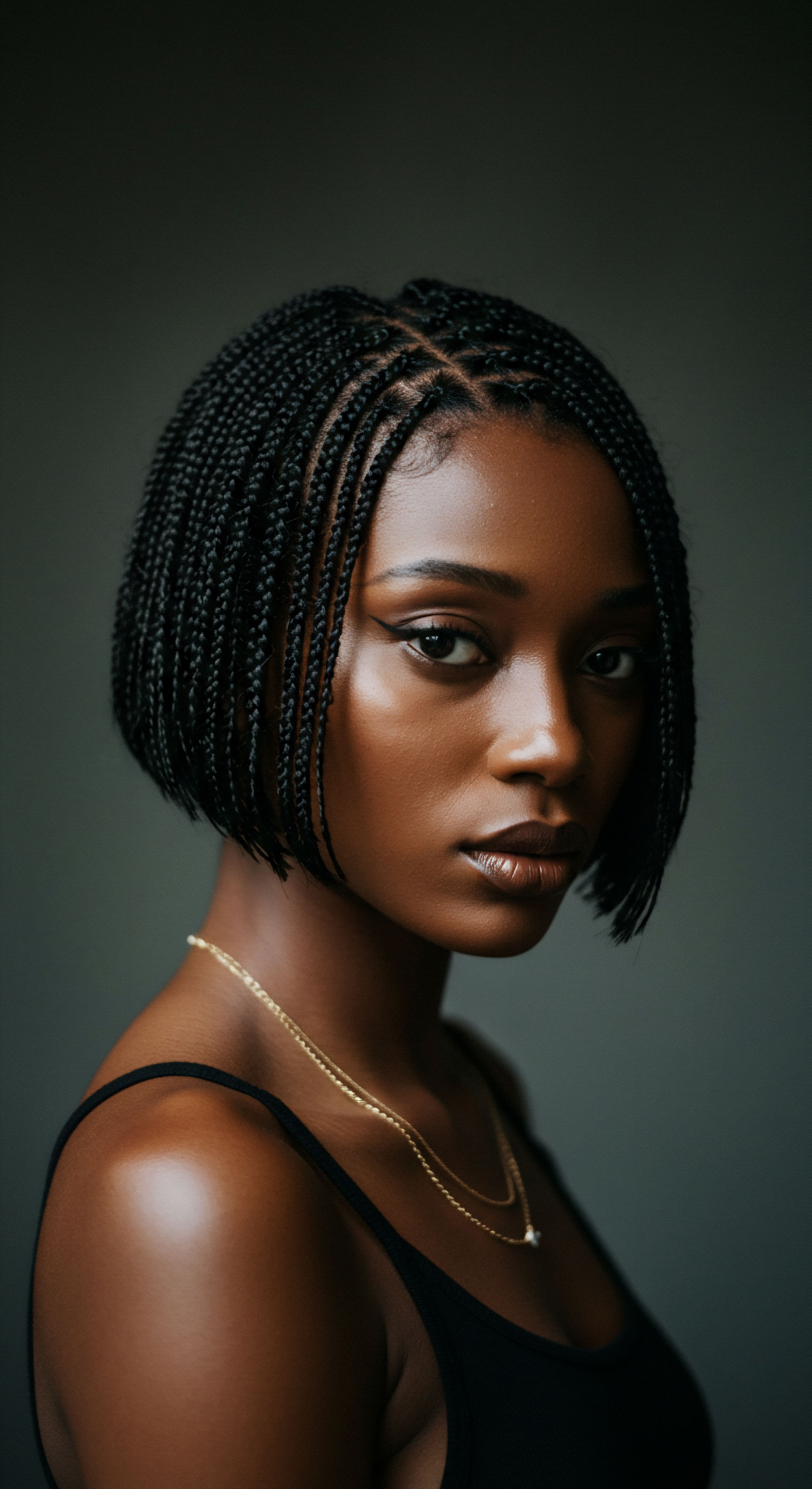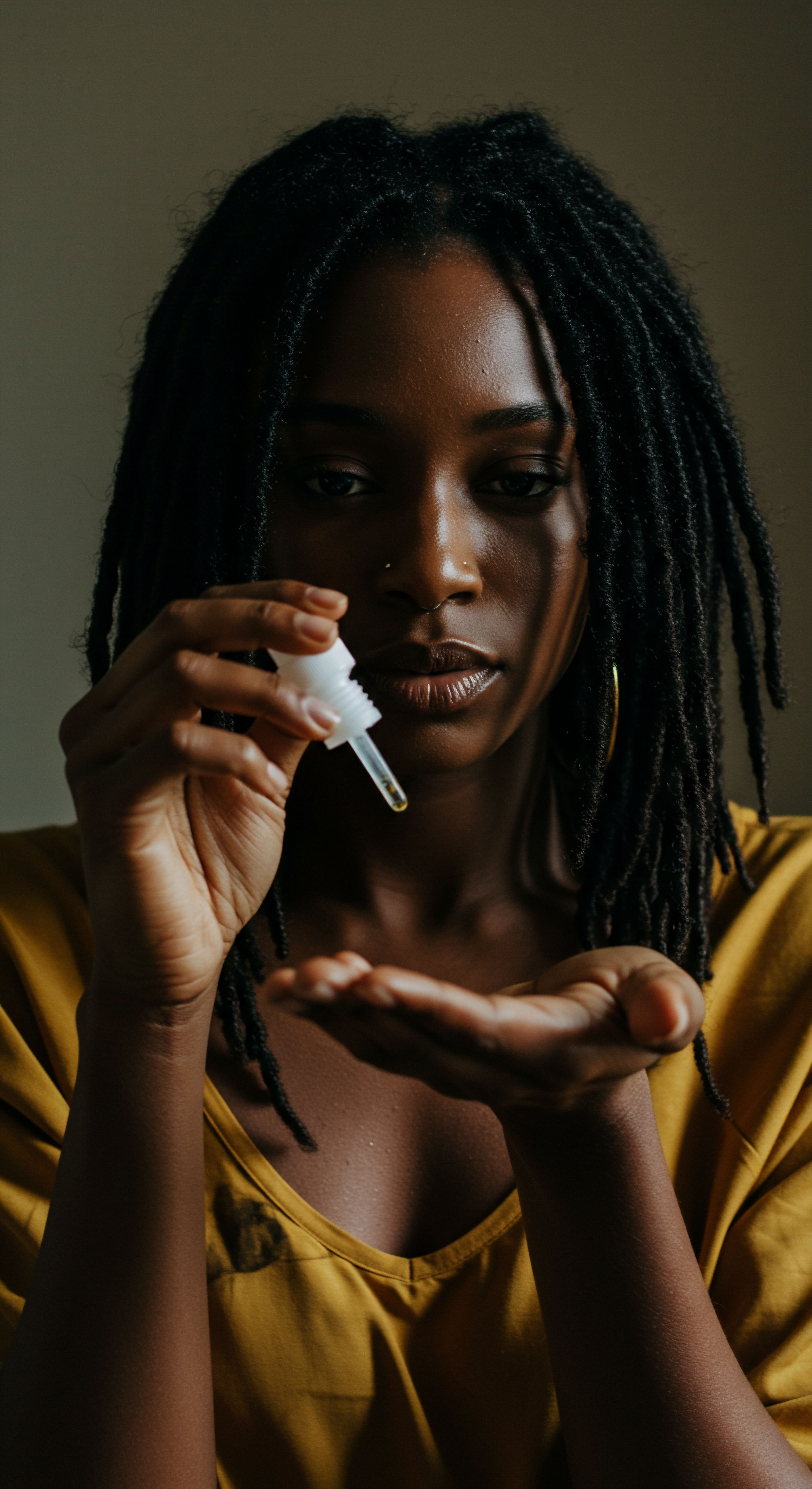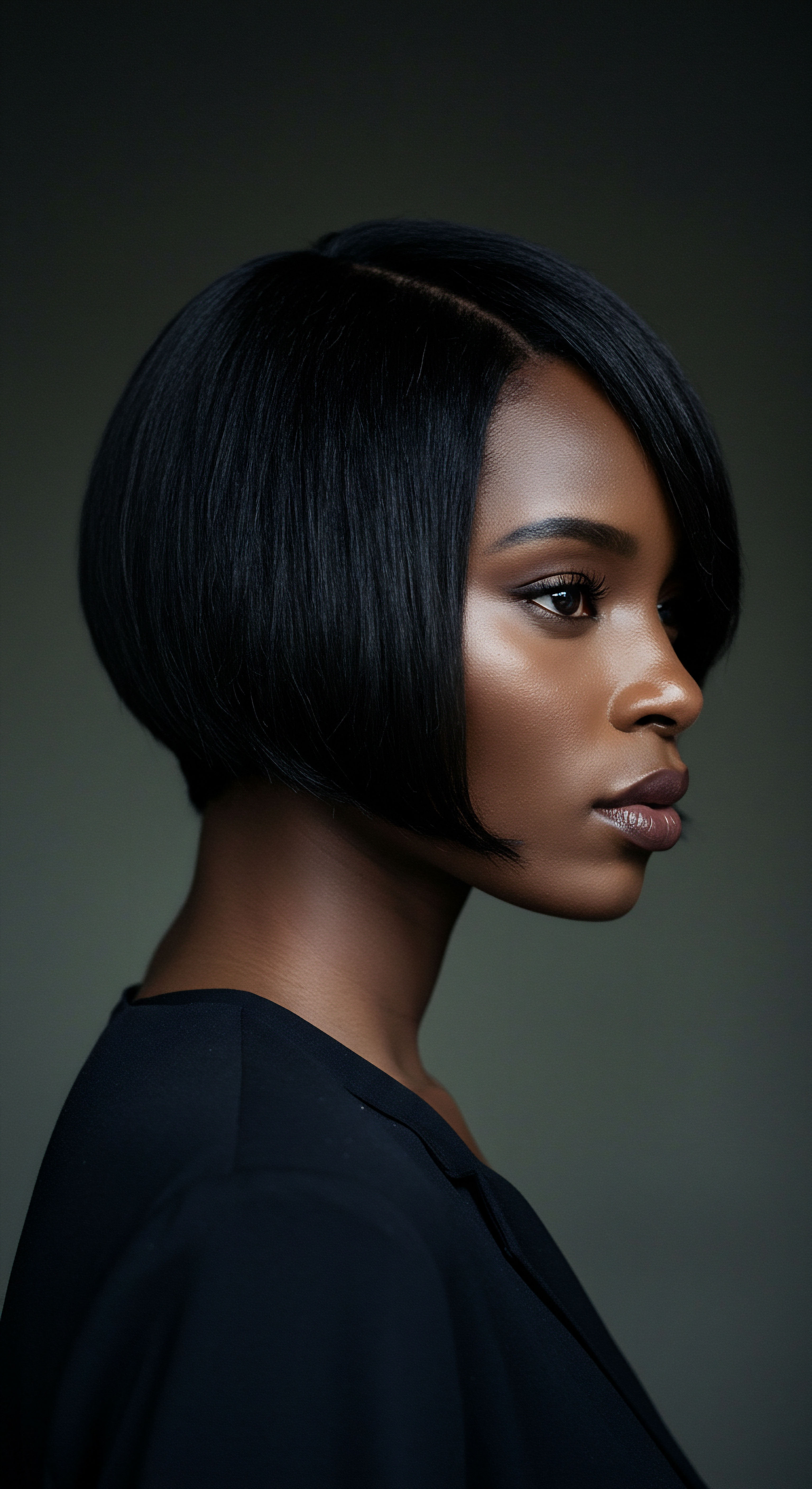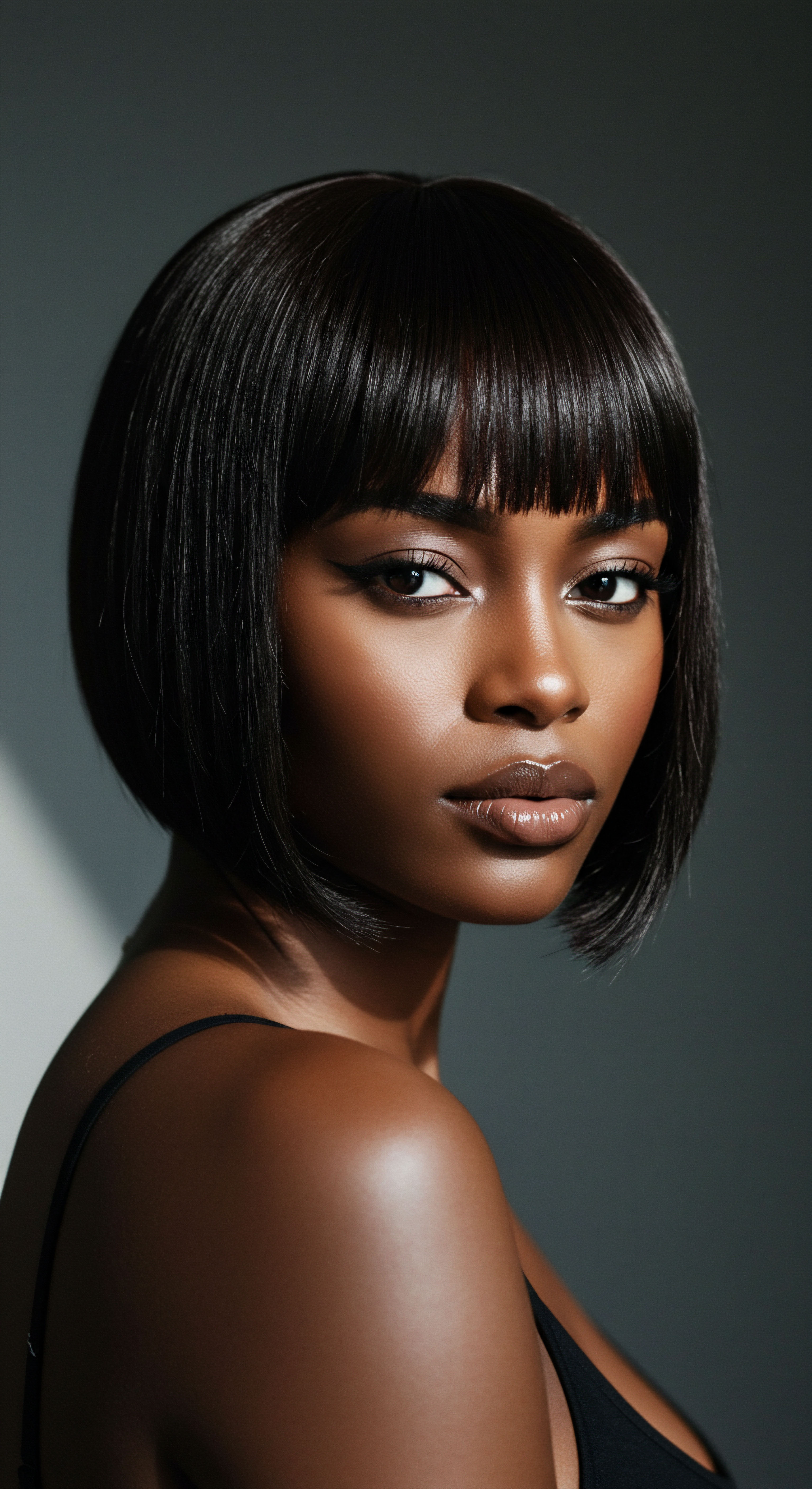
Roots
Consider for a moment the quiet moments before dawn, as the world settles into its deepest slumber. For those with textured hair, this period holds a unique tension. The very act of resting, of seeking restoration, can inadvertently diminish the hair’s most vital attribute ❉ its hydration.
The subtle interplay between the strands and the surfaces upon which we sleep initiates a silent, persistent drawing away of moisture, a challenge often unseen but deeply felt. Understanding this dynamic begins not with a remedy, but with an appreciation for the intrinsic nature of textured hair itself.

The Unique Architecture of Textured Hair
Each strand of textured hair, whether it forms gentle waves, tight curls, or compact coils, possesses a distinct anatomical blueprint. Unlike straight hair, which typically presents a round cross-section, textured hair often exhibits an elliptical or even flattened shape. This structural variance contributes to its characteristic curl pattern, but it also means the cuticle, the outermost protective layer of the hair shaft, does not lie as smoothly or uniformly flat. Think of the cuticle as a shingled roof; on straight hair, these shingles lie neatly, creating a smooth surface.
On textured hair, these “shingles” are more prone to lifting, especially at the curves and bends of each coil. This natural tendency for the cuticle to be slightly raised creates more points of contact and friction with external surfaces, and crucially, allows for a quicker escape of internal moisture.
The internal structure, the cortex, also plays a part. It forms the bulk of the hair and contains the protein bundles that give hair its strength and elasticity. When the cuticle is compromised, the cortex becomes more vulnerable to environmental stressors and water loss. This intrinsic morphology of textured hair makes it inherently more susceptible to dehydration than its straighter counterparts.
The unique, non-uniform cuticle structure of textured hair inherently predisposes it to greater moisture loss compared to straight hair.

Essential Hair Language for Hydration
To truly grasp how sleep affects hair’s hydration, we must speak a common language. Several terms illuminate the scientific underpinnings of hair health:
- Cuticle ❉ The outermost layer of the hair shaft, composed of overlapping cells that act as a protective barrier. When healthy, it lies flat, sealing moisture within.
- Cortex ❉ The primary structural component of hair, located beneath the cuticle. It contains keratin proteins and melanin, which determine hair’s strength, elasticity, and color.
- Porosity ❉ This refers to the hair’s ability to absorb and retain moisture. Hair with high porosity has more open or raised cuticles, allowing water to enter and leave more easily. Low porosity hair has tightly closed cuticles, making it harder for water to penetrate, but also harder for it to escape. Textured hair often leans towards higher porosity due to its cuticle structure.
- Transepidermal Water Loss (TEWL) ❉ Though often discussed in skin science, the principle applies to hair. It describes the passive diffusion of water from within the hair shaft to the surrounding environment. When the cuticle is disrupted, TEWL from the hair increases.
The integrity of the cuticle is paramount. A healthy, well-sealed cuticle keeps moisture locked within the cortex, contributing to supple, resilient strands. When the cuticle is roughened or lifted, whether by mechanical action or environmental factors, the hair’s ability to hold water diminishes, setting the stage for dryness and fragility.

Hair Growth Cycles and Resilience
Hair follows a cyclical pattern of growth, rest, and shedding. While sleep friction does not directly halt the hair growth cycle, chronic mechanical stress can indirectly affect hair health and its perceived resilience. Hair that is repeatedly damaged at the cuticle level may become brittle and prone to breakage, which can appear as a reduction in overall hair density or length retention. The hair’s capacity to withstand these daily challenges, including those encountered during sleep, depends significantly on its baseline health.
Well-hydrated hair with intact cuticles is simply more elastic and less likely to snap under stress. When hair is parched, it loses its suppleness, making it more vulnerable to the very friction encountered nightly.

Ritual
Stepping from the quiet wisdom of hair’s fundamental nature, we now turn our attention to the daily practices, the rituals, that shape our hair’s well-being, particularly as night descends. The query of how sleep friction affects textured hair’s hydration often finds its practical answers within these consistent, mindful actions. This section explores the interplay of our nightly routines and the delicate moisture balance of textured hair, moving beyond mere understanding to a space of actionable care.

The Nightly Exchange with Sleep Surfaces
The hours we spend in slumber, though meant for repose, can paradoxically become a battleground for hair hydration. As we shift and turn through the night, our hair comes into continuous contact with pillowcases and bedding. For many, these surfaces are woven from cotton, a material celebrated for its absorbency. While this quality makes cotton comfortable for sheets, it becomes a silent adversary for textured hair.
Cotton fibers, with their microscopic roughness, create friction against the hair shaft. This friction can lift the hair’s delicate cuticle scales, much like rubbing a hand against the grain of a pinecone. Once these scales are raised, the hair’s internal moisture, so carefully nurtured throughout the day, can more easily escape into the absorbent cotton fabric.
Beyond simple absorption, the mechanical stress of tossing and turning against a coarse surface can also lead to tangles, knots, and ultimately, breakage. This breakage not only reduces hair length but also creates new, exposed ends that are even more susceptible to moisture loss.

Why Traditional Pillowcases Cause Trouble for Textured Hair
Traditional pillowcases, typically cotton, present a twofold challenge for textured hair.
- Moisture Wicking ❉ Cotton is hydrophilic, meaning it readily absorbs water. As hair rests on a cotton pillowcase, the fabric draws moisture from the hair strands, leaving them drier and more prone to frizz by morning. This is particularly impactful for textured hair, which already struggles with retaining moisture due to its unique structure.
- Increased Friction ❉ The relatively rough surface of cotton fibers creates significant friction as hair moves against it. This mechanical abrasion roughens the cuticle layer, leading to increased porosity and further moisture loss. This friction also contributes to tangling and the formation of single-strand knots, which can then lead to breakage when detangling.
Cotton pillowcases, while comfortable for sleep, actively draw moisture from textured hair and cause abrasive friction, contributing to dryness and damage.

The Protective Wisdom of Bonnets and Smooth Fabrics
For generations, particularly within Black communities, the practice of covering hair at night has been a cornerstone of hair preservation. This tradition, often involving bonnets, headwraps, or silk scarves, carries deep cultural significance alongside its practical benefits. Originating in various African regions where headwraps served as markers of identity and status, and later becoming a protective measure during and after periods of enslavement, these coverings shielded hair from harsh conditions and preserved styles. The adoption of materials like satin and silk for sleep caps, especially since the mid-20th century, transformed this practice into a highly effective method for moisture retention and friction reduction.
The Silk and Satin Difference ❉ Unlike cotton, silk and satin possess a smooth, low-friction surface. When hair glides across these materials, the cuticle remains undisturbed, preventing moisture loss and minimizing tangles.
| Material Cotton |
| Friction Level High |
| Moisture Absorption High (absorbent) |
| Hair Benefits Increased frizz, tangles, breakage, dryness |
| Material Silk |
| Friction Level Low |
| Moisture Absorption Low (less absorbent) |
| Hair Benefits Reduced frizz, less tangling, moisture retention, cuticle smoothness |
| Material Satin (Polyester) |
| Friction Level Low |
| Moisture Absorption Low (less absorbent) |
| Hair Benefits Reduced frizz, less tangling, moisture retention (can trap heat) |
| Material Selecting sleep surfaces with low friction and low absorbency is crucial for preserving textured hair's hydration. |

Crafting a Nighttime Regimen for Textured Hair
A thoughtful nighttime routine is not merely about covering hair; it is about preparing it for rest and minimizing the hydration challenges posed by sleep.
Pre-Sleep Preparation:
- Moisturize and Seal ❉ Before bed, apply a lightweight leave-in conditioner or a hydrating cream to your hair, followed by a sealing oil or butter. This creates a protective layer that helps lock in moisture and reduces the hair’s susceptibility to drying out overnight.
- Gentle Detangling ❉ Carefully detangle hair with a wide-tooth comb or fingers. Never comb dry textured hair, as this causes breakage. A gentle approach reduces existing tangles that could worsen with sleep friction.
- Protective Styling ❉ Loosely braid, twist, or pineapple your hair. A loose bun or ponytail at the crown of the head can also keep hair contained and off the neck and pillow, further minimizing contact and friction.
These practices, when combined with the use of a silk or satin bonnet or pillowcase, create a sanctuary for textured hair, allowing it to retain its precious moisture and remain supple through the night.

Relay
We turn now to a more intricate understanding of how sleep friction, often dismissed as a minor annoyance, wields a considerable influence over the hydration of textured hair. This exploration transcends surface-level observations, delving into the precise biophysical mechanisms and the historical echoes that underscore the enduring wisdom of protective nighttime practices. Here, science and cultural intelligence converge to illuminate the profound connection between slumber and strand vitality.

The Biophysical Dance of Friction and Water Loss
At its heart, sleep friction is a mechanical force that interacts with the delicate surface of the hair shaft. Each movement against a pillow, particularly one made of absorbent, rough materials like cotton, generates abrasive action. This constant rubbing leads to the lifting and disruption of the hair’s cuticle layers. Think of the cuticle as a series of overlapping shingles on a roof.
When these shingles are smooth and flat, they form an effective barrier, keeping the internal moisture locked within the hair’s cortex. However, friction causes these shingles to abrade, fray, and lift, creating microscopic openings.
Once the cuticle is compromised, the hair’s intrinsic lipid barrier, which acts as a natural sealant, becomes less effective. This allows for an accelerated rate of transepidermal water loss (TEWL) from the hair shaft itself. While TEWL is typically associated with skin, the principle of water evaporating from a permeable surface applies to hair.
When the hair’s outer defense is weakened, water molecules within the cortex escape into the drier environment of the air or are absorbed by a thirsty pillowcase. This constant drawing away of water throughout the night leads to dehydration, making the hair feel rough, appear dull, and become more susceptible to further damage.
Furthermore, friction generates static electricity. This electrical charge causes individual hair strands to repel each other, contributing to frizz and further disrupting the cuticle alignment. This creates a self-perpetuating cycle ❉ friction leads to cuticle damage, which leads to moisture loss and frizz, which in turn increases the hair’s susceptibility to more friction and damage.

Beyond the Surface ❉ Microscopic Consequences of Nightly Abrasion
To truly appreciate the cumulative impact of sleep friction, one must consider the changes occurring at a microscopic level. Repeated nightly abrasion, even if seemingly minor, leads to progressive weathering of the hair shaft. This weathering manifests as damage and raising of the cuticle cells, and over time, a loss of the protective fatty layer that coats the hair.
The cortex, the hair’s inner core, becomes exposed, rendering it vulnerable to external elements and rapid moisture evaporation. This exposure can lead to internal structural weaknesses, making the hair brittle and prone to splitting and breakage.

Does Consistent Sleep Protection Truly Alter Hair Hydration Markers?
The efficacy of sleep protection is not merely anecdotal; it is increasingly supported by scientific observation. While direct, large-scale studies specifically quantifying changes in textured hair hydration markers due to sleep friction are still developing, existing research on fabric properties and hair damage provides compelling evidence. For instance, a study published in the Journal of Cosmetic Dermatology confirms that smoother fabrics like silk significantly help prevent hair shaft damage caused by repeated friction, reducing friction by up to 43% compared to cotton. This reduction in mechanical stress directly correlates with a more intact cuticle layer, which is the primary barrier against moisture loss.
Consider the broader implications ❉ if silk reduces friction by nearly half, it stands to reason that the rate of cuticle lifting and subsequent moisture evaporation would also see a substantial decrease. While direct measures of hair shaft TEWL on textured hair under different sleep conditions are less common, the established understanding of cuticle integrity and its direct link to moisture retention provides a strong theoretical basis. The consistent observation by users of silk and satin accessories of reduced dryness, tangling, and frizz further supports this. The absence of widespread, direct quantitative data for textured hair hydration specifically during sleep with different fabrics does not diminish the practical, observable benefits, but rather highlights an area ripe for deeper scientific inquiry into the specific biophysical responses of diverse hair types.

Cultural Continuities ❉ Sleep Protection Across Generations
The practice of covering hair for sleep, particularly within communities with textured hair, is far from a modern trend; it is a cultural continuity, a whispered wisdom passed down through generations. Historically, head coverings held profound significance in many African societies, denoting status, marital state, or even serving as coded communication. When African women were brought to the Americas during enslavement, headwraps were sometimes forced upon them as symbols of subservience, yet they also became a practical means to protect hair from harsh labor conditions and maintain hygiene.
This complex history laid the groundwork for the modern use of bonnets and scarves. Post-slavery, and particularly with the rise of the natural hair movement, the bonnet transformed from a symbol of oppression into one of self-care, cultural pride, and hair preservation. It represents a collective understanding that textured hair requires particular care to thrive, especially during vulnerable nighttime hours.
This deep-seated knowledge, born of necessity and passed through oral traditions, anticipated scientific findings on friction and moisture loss long before laboratory studies confirmed them. It is a testament to an enduring cultural intelligence that recognized the relationship between hair health and sleep protection.

The Environmental Echo ❉ Sleep Surfaces and Humidity’s Role
The microclimate of our sleep environment also plays a role in hair hydration, interacting with the effects of sleep friction. Ambient humidity, the amount of water vapor in the air, can influence how quickly hair loses or gains moisture. In a dry environment, hair is more prone to losing water, especially if its cuticle is already compromised by friction.
Conversely, in a highly humid environment, hair can absorb too much moisture, leading to swelling of the hair shaft and potentially causing hygral fatigue if there is excessive swelling and unswelling. This can also cause the cuticle to lift, making it more susceptible to friction damage.
While humidity can sometimes be perceived as a cause of frizz, it also presents an opportunity. When hair is well-hydrated and its cuticle is sealed (perhaps by protective styling and low-friction surfaces), it can benefit from moderate humidity, appearing softer and more supple. However, if the cuticle is roughened by sleep friction, even moderate humidity can lead to uncontrolled swelling and frizz, as the hair attempts to absorb moisture unevenly. The choice of sleep surface thus becomes even more critical in varying humidity levels, acting as a buffer against both excessive moisture loss in dry air and uncontrolled moisture absorption in humid conditions, especially when friction is minimized.

Reflection
As the soft light of morning graces the world, the story of our hair’s nightly passage reveals itself not as a simple matter of tangles or frizz, but as a quiet testament to enduring care. The interaction between textured strands and the surfaces of slumber is a delicate dance, one that speaks to the profound influence of seemingly small daily habits on the vitality of our crowns. This journey through hair’s anatomy, the wisdom of ancestral rituals, and the precise science of friction underscores a singular truth ❉ true well-being for textured hair is a continuous conversation, a mindful acknowledgment of its unique needs. It is in this gentle, informed approach that we find not only protection but a deeper appreciation for the beauty and resilience of each strand.

References
- 1. Donaldson, S. (2022). The Significance and History of Bonnets. Byrdie.
- 2. Annie International, Inc. (2023). The Origin Story Of The Bonnet.
- 3. YANIBEST. (2024). The Satin Bonnet ❉ Embracing History, Beauty, and Diversity.
- 4. Katsande, R. (2015). The history & meaning of head wraps across Africa. Wilderness Safaris.
- 5. Blissy. (2025). Is Silk or Satin Better for Hair? TikTok’s Viral Hack vs. Science.
- 6. Hype Hair. (2023). Unveiling the History of the Hair Bonnet for Black Women.
- 7. JD Institute of Fashion Technology. (2021). HEADWRAPS ❉ HISTORY AND EVOLUTION.
- 8. YouTube. (2024). Sweet Dreams ❉ a History of the Nightcap.
- 9. AFRISILK. The History of Bonnets.
- 10. The History and Evolution of Hair Bonnets ❉ From Traditional to Modern Styles. (2024).
- 11. Little Extra. (2023). How to Prevent Split Ends While Sleeping.
- 12. Typology. (2024). The consequences of a lack of sleep on your hair.
- 13. Jemec, G. B. E. et al. (2013). International guidelines for the in vivo assessment of skin properties in non-clinical settings ❉ Part 2. transepidermal water loss and skin hydration. Skin Research and Technology, 19(2), 127-134.
- 14. Esme Luxury. (2024). Silk Hair Wraps in Different Cultures ❉ A Global Perspective.
- 15. DiStefano Hair Restoration Center. (2025). Does Sleep Affect Hair Health?
- 16. McMullen, R. L. et al. (2020). Evaluation of the surface properties of hair with acoustic emission analysis. Journal of Cosmetic Science .
- 17. Trichology. (2024). Discover How Melatonin Can Promote Hair Growth & Fight Hair Loss.
- 18. Silk Works. Discover how silk pillowcases transform your sleep, skin, and hair.
- 19. scooms. (2024). Are silk pillowcases good for hair?
- 20. McMullen, R. L. Gillece, T. & Schiess, T. (2022). Physicochemical Properties of Textured Hair. Journal of Cosmetic Science, 72(6), 711-731.
- 21. Slipssy. (2025). Slipssy’s First-Night Effect ❉ How Reducing Friction Transforms Your Hair Overnight.
- 22. Taking Advantage of Humid Weather for Hair Growth. (2022).
- 23. Sano, M. et al. (2023). Friction dynamics of human hair treated with water or cationic surfactant aqueous solution. Journal of Surfactants and Detergents, 26(2), 185-194.
- 24. Prose Beauty. (2025). How to Keep Hair Straight in Humidity.
- 25. Sleep Foundation. (2024). Is It Bad to Sleep With Wet Hair?
- 26. Helix Hair Labs. (2023). IS HAIR BREAKAGE HAPPENING WHILE YOU SLEEP?
- 27. Draelos, Z. D. (n.d.). Articles – Hair.
- 28. I Love Riccio. How not to damage curly hair at night.
- 29. Balance Hair Care. (2023). How can humidity affect your hair and how to manage it?
- 30. DiStefano Hair Restoration Center. (2025). Does Dehydration Cause Hair Loss?
- 31. Birico. Silk vs Cotton ❉ Which Pillowcase Is Better for Your Skin and Hair?
- 32. About Faces Day Spa & Salon. (2024). Seasonal Hair Challenges ❉ How to Tackle Humidity.
- 33. Odele Beauty. (2021). What’s The Deal With Silk Pillowcases?
- 34. Nonomura, Y. et al. (2020). Tactile Texture of Cosmetic Sponges and Their Friction Behavior under Accelerated Movement. Tribology Letters, 68(3), 1-8.
- 35. CLOUD NINE. (2024). Tips for Managing Hair and Taming Frizz in Humid Weather.
- 36. Ishibashi, A. & Taniguchi, H. (2019). Usefulness of barrier function index based on water content and transepidermal water loss for evaluating efficacy of skin protective creams. OAText Journal of Clinical and Medical Case Reports, 3(2).
- 37. Konno, S. Asanuma, K. & Nonomura, Y. (2024). Friction Dynamics of Straight, Curly, and Wavy Hair. Journal of Oleo Science, 73(5), 801-811.
- 38. Defying Damage ❉ Understanding Breakage in Afro-textured Hair. (2020). Cosmetics & Toiletries .
- 39. Penn State University. (2025). Mane attraction ❉ Molecular ‘switch’ may control long scalp hair.
- 40. Koyama, Y. et al. (2000). Oral Intake of Glucosylceramide Improves Relatively Higher Level of Transepidermal Water Loss in Mice and Healthy Human Subjects. Journal of Oleo Science, 49(11), 1013-1018.
- 41. Science works to demystify hair and help it behave. (2024).
- 42. Sleep Masks and Hair Care ❉ Prevent Breakage and Frizz.
- 43. CLOUD NINE. (2024). The Importance of Hair Hydration.
- 44. UMBC ❉ University Of Maryland, Baltimore County. (2023). Why Does Your Hair Curl In The Summer? A Chemist Explains The Science Behind Hair Structure.
- 45. Lee, Y. et al. (2011). Hair Shaft Damage from Heat and Drying Time of Hair Dryer. Annals of Dermatology, 23(Suppl 2), S160-S164.
- 46. Medical News Today. (2020). Black hair care tips for washing, styling, and more.
- 47. Hygral Fatigue (Over-Conditioned Hair) Causes, Symptoms, Treatment. (2020). Healthline.
- 48. Konno, S. Asanuma, K. & Nonomura, Y. (2024). Friction Dynamics of Straight, Curly, and Wavy Hair. ResearchGate .